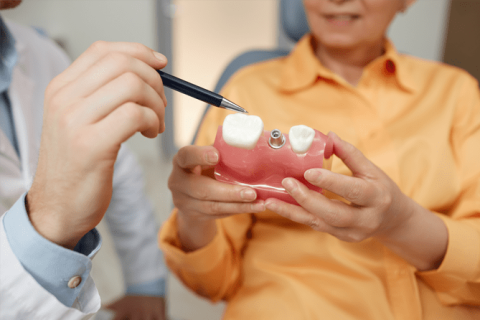Missing all your teeth can be frustrating and impact your smile, confidence, and ability to eat. Fortunately, advanced dental techniques like All-on-4 and All-on-6 can help you regain a beautiful smile, natural-looking teeth, and normal dental functions.
How Do They Work?
Both methods use fixed dental prostheses (artificial teeth) anchored to dental implants. However, they differ in the number of implants used:
- All-on-4: Uses four implants, two placed vertically in the front and two positioned at a 45-degree angle in the back. This technique is less invasive and requires a shorter surgery.
- All-on-6: Uses six implants, offering greater stability than All-on-4. This technique may require a longer and more complex surgery.
Who Are Good Candidates?
Both techniques are ideal for patients with multiple missing teeth. However, they may not be suitable for everyone. Your dentist will examine your gums and bone structure to determine if either method is right for you.
What are the Advantages of All On Four and All On Six Implant Types?
All-on-4 and All-on-6 implants have many important advantages. Some of these are listed below.
- Faster Healing:
Less invasive compared to other implant types.
Requires less bone surgery, leading to quicker recovery.
- Minimal Implants Needed:
Replaces all missing teeth with only 4 or 6 implants.
Eliminates the need for numerous implants required for traditional dentures.
- Reduced Bone Surgery:
Requires fewer surgical procedures compared to conventional implant treatments.
Minimally invasive, promoting faster healing.
- Cost-Effective:
Requires fewer implants, resulting in lower costs compared to other solutions.
- Quicker Treatment Time:
Addresses all missing teeth with fewer implants, reducing treatment duration.
Eliminates the need for placing multiple artificial teeth for traditional dentures.
- Natural-Feeling Teeth:
All-on-4 and All-on-6 implants provide fixed dental prostheses that function like natural teeth.
Eliminates the discomfort and limitations associated with some dental solutions.
- Ideal for Suitable Candidates:
Offers an ideal treatment option for individuals who meet specific criteria.
Requires a personalized assessment to determine candidacy.
Overall, All-on-4 and All-on-6 implants offer significant advantages for individuals seeking to restore their complete smile. However, it’s important to consult a dental professional for personalized evaluation and treatment recommendations.The Bottom Line
Both All-on-4 and All-on-6 can be excellent options for restoring your smile and oral health. Discussing your specific needs and preferences with your dentist will help you determine the best option for you.
All-on-4 and All-on-6 Implant Application Process:
Preparation:
- Evaluation:
- General health assessment
- Examination of gums and jawbone structure
- Assessment of teeth, swallowing, chewing functions, oral hygiene, habits, and personal needs
2.Treatment Plan:
- Customization based on individual needs
- Selection of implant type (All-on-4 or All-on-6)
Surgical Procedure:
- Anesthesia:
- Local or general anesthesia depending on patient preference and complexity
- Implant Placement:
- Surgical preparation of the area
- Incision of the gum tissue
- Drilling of holes in the jawbone
- Placement of implants into the prepped holes implant placement in jawbone
- Implant Fixation:
- Compression of implants using specialized tools
- Ensuring secure attachment to the jawbone
- Temporary Prosthesis:
- Attachment of a temporary prosthesis over the implants
- This prosthesis remains in place during healing
- Serves as a placeholder until permanent prostheses are ready
Permanent Prosthetic Placement:
- Fabrication:
Customized permanent prosthetics are created in a dental lab
- Attachment:
Once healed, the temporary prosthesis is removed
Permanent prostheses are securely attached to the implants
Specifics of Implant Placement:
Front implants placed vertically at 90 degrees
Back implants placed at a 45-degree angle
All implants placed vertically at 90 degrees
Additional Notes:
The application process may vary slightly depending on individual cases and the chosen technique.
Recovery time after the surgery is typically faster compared to traditional implant procedures.
Regular follow-up appointments are crucial to ensure optimal healing and long-term success.
Overall, All-on-4 and All-on-6 implant procedures offer a minimally invasive and efficient solution for restoring missing teeth. Consulting with a qualified dental professional is crucial for a personalized assessment and treatment plan.
Aftercare Tips for Optimal All-on-4 and All-on-6 Implant Success
Post-Surgical Comfort:
- Swelling and Pain: Expect mild swelling and pain in the mouth for the first few days. Take prescribed pain relievers regularly for maximum comfort.
- Medication: Use mouthwash solutions and antibiotics as directed by your dentist to promote healing and prevent infection.
Oral Hygiene:
- Special Toothbrush: Use a soft toothbrush recommended by your dentist to clean around the implants.
- Flossing: Gently floss the area around the implants with a soft floss or water flosser before brushing.
- Dietary Restrictions: Avoid very hot or cold foods and drinks for the first few days to prevent tissue damage.
Follow-up Care:
- Regular Checkups: Attend all follow-up appointments recommended by your dentist. These checks allow for monitoring implant healing and addressing any potential issues promptly.
- Early Intervention: Promptly report any concerns or complications to your dentist for timely diagnosis and intervention.
Additional Tips:
- Soft Diet: Eat soft foods for the first few days to avoid discomfort and promote healing.
Smoking Cessation: Smoking can interfere with healing and jeopardize implant success. Quitting smoking is highly recommended.
- Alcohol Moderation: Limit alcohol consumption to avoid irritating the healing tissues.
- Good Oral Hygiene: Maintain good oral hygiene practices by brushing and flossing regularly.
By following these considerations and your dentist’s instructions, you can ensure successful healing and optimal outcomes for your All-on-4 or All-on-6 dental implants.


